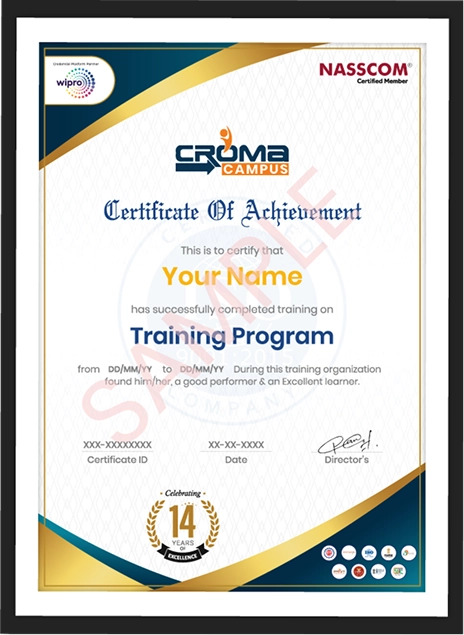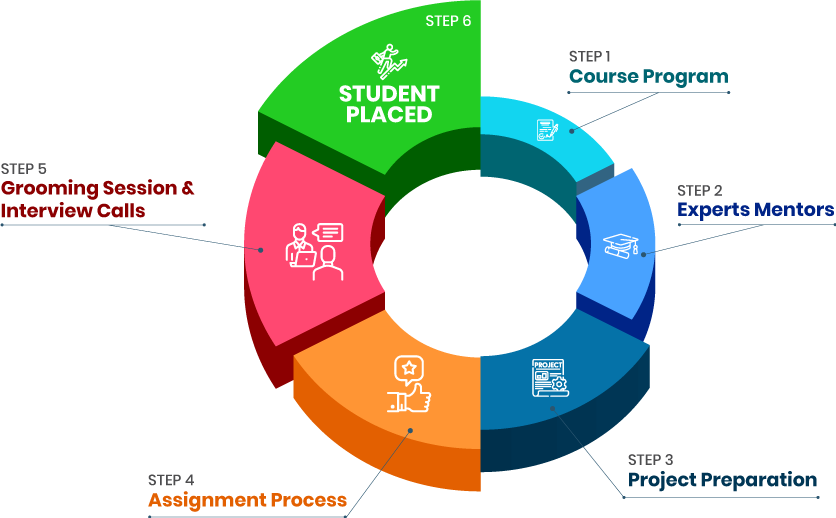Course Design By
Nasscom & Wipro
By deep-delving into its actual, you will find various sections, and some of the major ones are mentioned below.
Right at the beginning of the Artificial Intelligence Online Training in India, you will first understand its basic information, like definitions, main uses, and industries involved.
Further, you will receive sessions regarding building an AI.
Our highly qualified trainers will also help you know how to solve actual problems by implementing AI measures.
You will also get a deep insight into Q-Learning.
Deep Q-Learning, and Deep Convolutional Q-Learning.
You will also get the opportunity to know about the main theory behind Artificial Intelligence.
Well, Artificial Intelligence Online Training will also help you know learning intuition, learning visualization, etc.
In a way, you will end up knowing each and every bit of Artificial Intelligence Online Training in India in a much better way.
Well, as a fresher AI Developer, you will earn around Rs. 8 Lakhs per year in the beginning.
Further, you will earn around even higher salary around Rs. 50 Lakhs annually.
Well, later in your career this salary structure will get expanded by imbibing more skills, and the latest information.
Post having this skill, you will be able to enter into a multi-national company that will also offer you a quite higher salary package.
By getting started with Artificial Intelligence Online Training in India, you will turn into a knowledgeable AI Developer.
Enrolling in this course will allow you to examine this subject right from the scratch.
By knowing every side of Artificial Intelligence Online Training in India, you will end up acquiring a higher position.
Your basic AI knowledge will get strengthened.
You will have several international jobs offers in hand as well.
Your foremost duty will be to solve various business challenges utilizing AI software.
You will also have to design, develop, implement, and monitor AI systems.
Furthermore, you need to also describe to project managers and stakeholders the potential and limitations of AI systems.
You will also have to build data ingest and data transformation architecture.
Moreover, you might also have to look out for new AI technologies to imply within the business.
One of the main reasons is its hugely increasing demand for skilled professionals in AI Developers.
Moreover, it has a wide bright future ahead.
By knowing this technology, you will be able to integrate complicated tasks without the need of cost delays respectively.
You will get a series of job roles in this field as well.
Immense openings for skilled developers in huge companies.
Precily Private Limited, Iora Ecological Solutions, Gauge Data Solutions Pvt Ltd, etc. are some of the well-established companies hiring skilled AI Developers.
Our faculty members will help you in clearing the interview by often conducting a mock test.
The main agenda of Artificial Intelligence Online Training is to assist you to get settled in a well-established workplace.
Getting in touch with us will give you ample chances to obtain the latest information concerning the Artificial Intelligence course.
Here, you will obtain information regarding its related course.
Croma Campus will offer you placement assistance.
Well, right from the beginning, our faculty members will give you suggestive tips to clear the interview process.
we train you to get hired.

By registering here, I agree to Croma Campus Terms & Conditions and Privacy Policy
+ More Lessons
Course Design By

Nasscom & Wipro
Course Offered By

Croma Campus

Stories
success
inspiration


career upgrad


career upgrad


career upgrad


career upgrad
05-Jul-2025*
07-Jul-2025*
02-Jul-2025*
05-Jul-2025*
07-Jul-2025*
02-Jul-2025*

You will get certificate after
completion of program

You will get certificate after
completion of program

You will get certificate after
completion of program
in Collaboration with






Empowering Learning Through Real Experiences and Innovation

we train you to get hired.

Phone (For Voice Call):
+91-971 152 6942WhatsApp (For Call & Chat):
+91-971 152 6942Get a peek through the entire curriculum designed that ensures Placement Guidance
Course Design By


Course Offered By

Ready to streamline Your Process? Submit Your batch request today!
Well, Artificial Intelligence is neither an easy nor a complicated course. But by acquiring adequate guidance, you will finish this course in just a few days.
Yes, it is one of the most looked for skills in an individual. Knowing AI will genuinely help you in staying in this field in the long run.
Yes, you can surely get started with our Online Artificial Intelligence course.
Topics may include machine learning, deep learning, neural networks, natural language processing, computer vision, AI ethics, data analysis, and more.

FOR QUERIES, FEEDBACK OR ASSISTANCE
Best of support with us
For Voice Call
+91-971 152 6942For Whatsapp Call & Chat
+91-9711526942